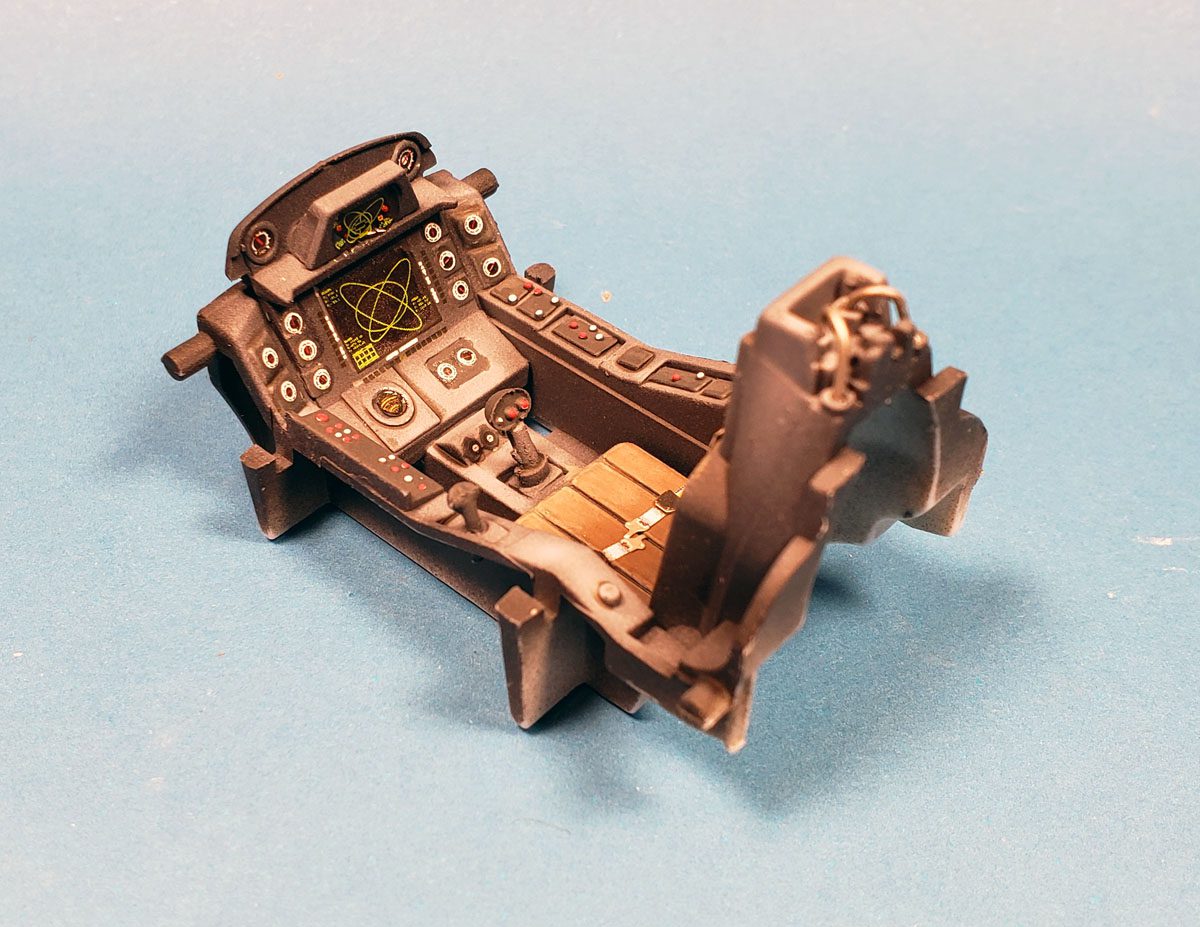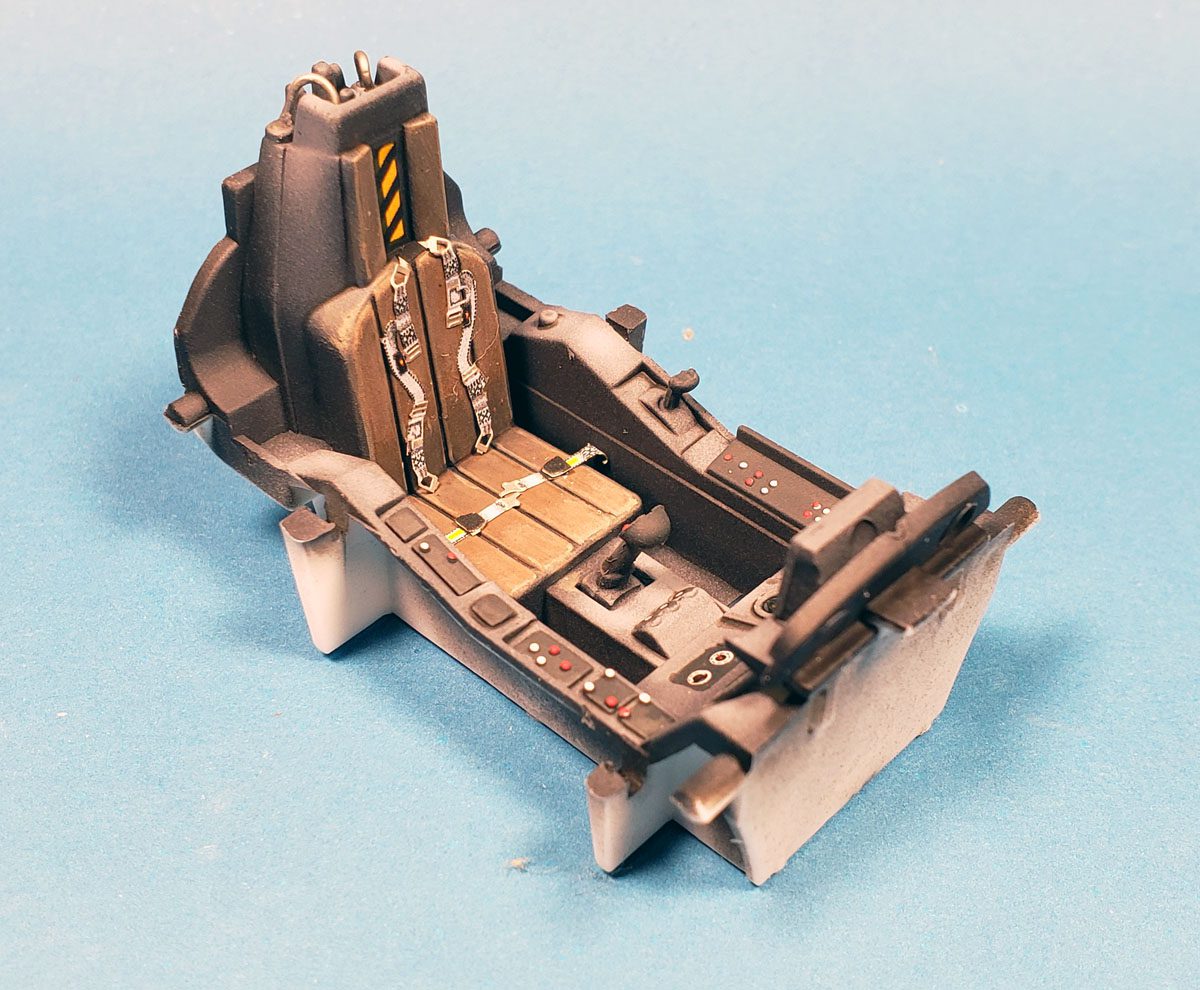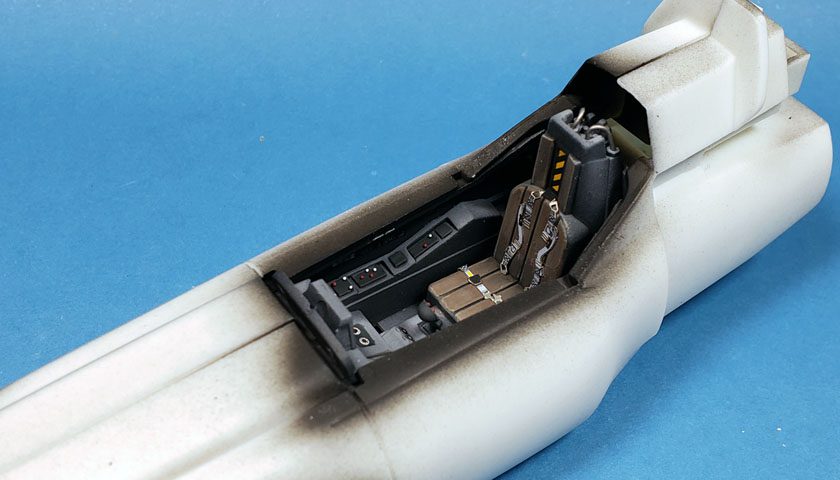After having built the Moebius 1/32 Colonial Viper Mk. I, looking through the sprues of the Mk. II kit seemed like familiar territory. While there’s nothing about the kit that could be described as an example of modern injection-molding, it all seems to work. Despite fairly thick plastic, some big sprue connectors, and more than a bit of flash, if it assembled anything like it’s Mk. I cousin, no serious problems would be encountered.
Test fitting supported this theory, with all major parts lining up nicely enough. It appeared that some seam line work would need to be done along the long fuselage seam on the upper and lower nose, but the fact that it’s all a big wide chunk of plastic makes it easy. Sand away… there’s plenty more underneath.
Becky, Look At That Cockpit
What I was pleasantly surprised to find in this box was a cockpit that had a bit more detailing. There were a few more lumps and bumps and knobs, and my initial thought was that it was good enough to consider an open cockpit build. (Plus, the pilot looked awful, just dreadful…) Even more surprising was the very thorough set of cockpit decals included, with multifunction displays, instrument gauges, and cockpit placards being included. A nice addition would have been some seat belts, so I figured I’d need to source something from the spares box for that.
Unlike the Mk. I cockpit, which I’d painted in “70s scifi blinky” style, I decided this one would be a bit more traditional. And because the rest of the model would be such a light color, having the cockpit in darker shades would provide a lot of contrast, and make it a focal point.
Work got underway with a primer coat of Badger Stynylrez Black, which would allow for deep shadowing as later paint layers were applied. Many people refer to this as “black-basing”, which while certainly a valid approach, seems a bit gimmicky to me in terms of the name. I saw folks painting things in a dark color, and then later adding highlights over it, long before “black basing” came in vogue. It makes me chuckle when I’m asked “do you black base?” I always reply “what is the purpose of black basing?” Rarely do I get an answer. 😉
All About That Base
A more traditional approach to painting a cockpit would be to give it a thorough coat of the base color, whether that be gray, or interior green, or whatever. Typical follow on steps would be to add highlights through painted edge highlighting, or drybrushing, and then shadowing with washes.
By starting at a black base (thus the term), and building up color from higher angles, the shadows are “built in” from the start. For this cockpit, I wanted the shadows to be just that – shadows – which would allow the main elements of the cockpit to be focal points. After priming, the airbrush was loaded with a dark gray color, and that was painted on with the airbrush held at about a 45 degree angle, roughly 4-5 inches above the cockpit tub. I use a small turntable to airbrush items on, so it was a simple matter of misting the color on while turning the stand slowly. Once I had it built up sufficiently, a quick examination didn’t show any areas that needed filling in.
A few drops of white were then added to the color cup, and a bit more thinners, and the cockpit was again airbrushed, though this time from a higher angle. The goal here was to only get the lighter colors in the higher spots. This helps bring out the more prominent areas even more.
More white was was again added to the color cup, but this time I was more direct in how the color was applied. I got in very close, with the air pressure turned way down, and tried to only spot highlight a few places that I wanted the viewer to notice. At that point, things looked a bit stark. While the color transitions were fairly smooth, there was too much contrast.
No worries, however. A simple way to blend things back together is to switch back to the original color – in this case the dark gray – and heavily thin it. I normally go with a 10-1 mix of thinner to paint. This color can then be lightly misted on. A general spray helps to start blending things, and then more precise spraying can tone areas that are too sharp in contrast down. The key is to proceed slowly, examining the piece closely with regularity.
The final effect produces (hopefully) nice color transitions with highlighting “mapped” in that will direct the viewer’s gaze. While it is essentially a zenithal shading technique, my aim for the cockpit was less to simulate actual lighting, and more to highlight focal points. The process is the same, but the logic (if I can dare use that word in relation to my work! 😉 ) is different.
With all of that done, I now had a grayish cockpit that looked a bit less stellar than the explanation would have you believe.
A Dozen Glazed. To Go.
I also wanted the seat to be a focal point, as it would be the most prominent part of the cockpit to be seen first. The seat cushions were first painted in a leather brown color. I’m not a precise enough airbrusher to add shadows and highlights within such a confined space, so I decided to try a technique I’ve been experimenting with.
Glazing is the process of putting a sweet, sugary coating on a donut, which makes them wonderful, tasty, and quite fattening. It’s also the name for a painting technique.
Glazing is when a paint or ink is thinned, using some medium, and then applied to the subject in very thin coats. These coats can then be built up, and if done well, impart a gradual fade from a lighter to a darker area, or between colors. The medium used to thin the paint can vary. For acrylics, there are glaze mediums made specifically for the purpose. However, given the small area I was working in, and being a cheap sort of fellow, I opted for water.
Starting by mixing the leather brown with beige, producing a warm, light brown, I then thinned it heavily with water. Using a #0 round brush, I touched it into the paint, then to a piece of tissue, to remove excess paint. The key to glazing is realizing that it’s not a wash, and it’s not a drybrush. It’s painting – just applying very thin, very translucent coats, one after the other.
I started about the mid-way point of the seat cushion, adding the glaze with strokes that went from mid-cushion to the front, and on the backrest, from mid-cushion to the top. When that dried, I applied another glaze layer, this time starting not quite at the mid-point. That procedure was repeated about six times, with each successive layer being started closer and closer to the edge.
While the glazing added some nice highlights, I did think the area where the seat and backrest merged needed a bit more shadow. Using the same process, only this time with a glaze of the leather brown and black, I added in just a bit of shadow. A final step was to add in some lighter edge highlighting to each cushion section.
When all finished, it looked very much like a middle-aged man had tried glazing a seat, which was exactly the result I had hoped for. 🙂
It’s a good technique, and one I will continue to work on, because it can be very useful in many ways. As with most things we modelers do, though, practice is the key. Still, I was rather happy with the result. (For a great video tutorial, check out Miniac’s work on the subject. It’s this that prompted me to use it on the seat.)
Finishing It Up
With the seat sorted out, a few dots of white were added to the various knobs and buttons in the cockpit, and some of those then had a dot of red added. Everything was then given a gloss coat of Future.
For a wash, I used Citadel’s Gloss Nuln Oil. This works very well over a glossy surface, as it reduces tide marks to a minimum, yet dries much, much faster than using oils or enamels. The kit supplied decals were added after that. They behaved OK, though several applications of Solvaset were needed to get them to fully settle. While they were workable, using them did convince me that the red stripes on the exterior will be painted on.
The final step was to find some seat belts. A quick rummage through my spares box turned up an Eduard steel set, conveniently pre-colored, designed for Tamiya’s 1//48 F-14A. I had to snip and combine various parts of the belts together in order for an acceptable look, but I thought it sold the concept nicely when in place. A final matte varnish sealed it all in place.
A test fit of the cockpit into the two fuselage halves showed it would be a drama free process to close the fuselage. Alignment pins on either side of the cockpit tub fitted into connectors in either fuselage half, which held the unit firmly and aligned just right. Don’t forget to add the small part aft of the seat, and also the small part just inside the nose intake, before gluing it all together.
Ask me how I know this… 😉
While the cockpit parts will not win any awards for precision, they are a nice step up from the Mk. I kit. There are photoetch sets available, and of course scratch building is an option also.
The fun part for me was further refining a technique I’d used before – the “black-basing” – and employing what is a new technique to me, glazing. Both are great examples of how working with a wide variety of application methods, from across genres, can really help you achieve a better look, and simply to have more fun. Even if you’re not a figure modeler, or into aircraft, or care to build Gunpla, or whatever… each of those modeling categories have their luminaries who can teach, and methods that can be useful. Explore the modeling world.
You never know what you’ll find that will add to your fun!









Leave a Reply